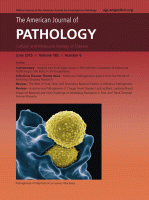 The American Journal of Pathology has posted a note of concern to a 2002 paper about retinoblastoma after discovering two sets of figures “share significant overlap… suggesting that they did not originate from different specimens.”
The American Journal of Pathology has posted a note of concern to a 2002 paper about retinoblastoma after discovering two sets of figures “share significant overlap… suggesting that they did not originate from different specimens.”
The overlap was “simultaneously brought to the attention of the Editors” by both the corresponding author and a “concerned reader.”
The paper examined the role of a transcription factor called NF-kappaB in driving retinoblastoma, and suggested that inhibiting the molecule’s activity could be a therapeutic strategy.
The authors attribute the overlap to “an inadvertent misidentification of the original files at the stage of image capture.” They add that they “sincerely regret this inadvertent error;” because other data in the paper show “concordant results,” they stand by the paper’s findings.
Here’s the note:
It has been brought to our attention that Figure 3 of “Constitutive Nuclear Factor-κB Activity Is Crucial for Human Retinoblastoma Cell Viability,” by Vassiliki Poulaki, Constantine S. Mitsiades, Antonia M. Joussen, Alexandra Lappas, Bernd Kirchhof, and Nicholas Mitsiades (Volume 161, pages 2229–2240 of the December 2002 issue of The American Journal of Pathology) contains errors, specifically that panels C and D share significant overlap with panels E and F, respectively, suggesting that they did not originate from different specimens. The matter was reviewed by the journal’s Editors.
This matter was simultaneously brought to the attention of the Editors by corresponding author Dr. Poulaki and by a concerned reader. Dr. Poulaki states, “We believe that the most likely explanation for this error is an inadvertent misidentification of the original files at the stage of image capture with Openlab software (PerkinElmer, Waltham, MA; circa 2001), which subsequently escaped our attention due to the quantitative similarity of panels B–F. We sincerely regret this inadvertent error.”
Dr. Poulaki adds further that “the TUNEL (terminal deoxynucleotidyl transferase-mediated dUTP nick-end labelling) assay in Figure 3 was used as an additional methodology to visually illustrate the finding of the MTT assay shown in Figure 4, namely that none of the caspase inhibitors used (ZVAD-FMK, DEVD-FMK, LEHD-FMK, IETD-FMK) can rescue the Y79 cells from SN50-induced cell death. This finding is also supported by the lack of caspase-9 cleavage or classical 85-kDa poly (ADP-ribose) polymerase cleavage fragment (Figure 5). Thus, the TUNEL assay was only one of several methodologies used in the paper with concordant results. We are therefore confident that the conclusions of our manuscript remain unaffected by this inadvertent error and are solid and reproducible.”
The editor-in-chief of the journal, Kevin A. Roth, told us he had nothing to add to the notice. Corresponding author Vassiliki Poulaki, at Harvard Medical School, did not reply to our request for comment.
The paper has been cited 29 times, according to Thomson Scientific’s Web of Knowledge.
Like Retraction Watch? Consider supporting our growth. You can also follow us on Twitter, like us on Facebook, add us to your RSS reader, and sign up on our homepage for an email every time there’s a new post.
Other Vassiliki Poulaki papers commented on at Pubpeer.
https://pubpeer.com/publications/12714660
https://pubpeer.com/publications/19641635
https://pubpeer.com/publications/14744874
https://pubpeer.com/publications/11901189
https://pubpeer.com/publications/16807368
https://pubpeer.com/publications/15277220
https://pubpeer.com/publications/3CF916E5F93F1A99EA8B2B6241456D
https://pubpeer.com/publications/11687554
https://pubpeer.com/publications/17400913
This paper
https://pubpeer.com/publications/BC2583DC8D9EC0521A906B6B2E2CE6
PubPeer appears to have multiple copies for this paper
See also
https://pubpeer.com/publications/12466137
http://www.boston.va.gov/features/Breakthrough_Eye_Cancer_Research.asp
https://forbetterscience.wordpress.com/2016/06/27/berlin-head-ophthalmologist-joussen-deploys-lawyer-to-silence-my-reporting-demands-from-me-e80000-damages/
Invest Ophthalmol Vis Sci. 2003 May;44(5):2184-91.
Contribution of TNF-alpha to leukocyte adhesion, vascular leakage, and apoptotic cell death in endotoxin-induced uveitis in vivo.
Koizumi K1, Poulaki V, Doehmen S, Welsandt G, Radetzky S, Lappas A, Kociok N, Kirchhof B, Joussen AM.
Author information
1Department of Vitreoretinal Surgery, Center for Ophthalmology, and Center for Molecular Medicine, University of Cologne, Cologne, Germany.
2016 erratum in Invest Ophthalmol Vis Sci. 2016 Feb;57(2):403. doi: 10.1167/iovs.02-0589a.
http://iovs.arvojournals.org/article.aspx?doi=10.1167/iovs.02-0589a
It was brought to the attention of the authors that bands demonstrating caspase-3 enzymatic activity in rat retinas in Figure 8A could have been assembled from different blots. The authors have now repeated the Western blot analysis. The new figure below repeats the results and should replace Figure 8A.
Graefes Arch Clin Exp Ophthalmol. 2007 May;245(5):665-75. Epub 2006 Oct 11.
Effect of gravity in long-term vitreous tamponade: in vivo investigation using perfluorocarbon liquids and semi-fluorinated alkanes.
Mackiewicz J1, Maaijwee K, Lüke C, Kociok N, Hiebl W, Meinert H, Joussen AM.
Author information
1Department of Vitreoretinal Surgery, Center for Ophthalmology, University of Cologne, Kerpener Strasse 62, 50924, Cologne, Germany.
2015 erratum. http://link.springer.com/article/10.1007%2Fs00417-015-3004-4
Unfortunately, an error occurred during the compilation of the composite Figure 3. Accidently the left panel of Figure 3a showing retina without surgery was transposed with the right panel of Figure 3a showing retina after surgery without tamponade. Both panels are now presented in the correct order. As no differences amongst both panels were detected the error does not affect the results and conclusion of this study. The authors apologise for any confusion that may result from this error.